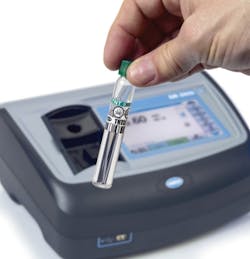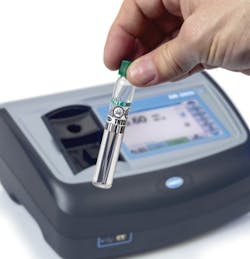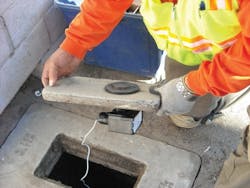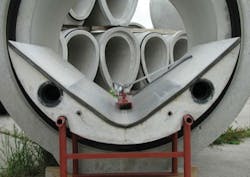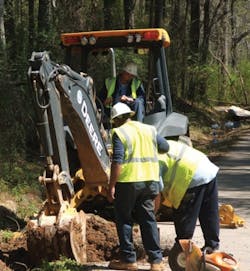Digital Technology Aids Leak Detection Program
By Jeffrey Jones
In 2000, Clayton County Water Authority’s non-revenue water loss was over 20%. The Board of Directors and CCWA Management Team took action to find a solution to this growing problem and embarked on a leak detection program.
Clayton County, GA, lies just south of Atlanta. CCWA produces up to 39 mgd and has a potable water storage capacity of 35.6 mg stored in 10 ground and eight elevated tanks. The authority owns and maintains five raw water reservoirs that provide raw water to three water production facilities. CCWA serves a population of 270,600 people through a system of distribution mains 1446 miles long.
The authority’s first step was to investigate and demonstrate several types of leak detection equipment. As their program evolved, CCWA eventually purchased three key detection systems from Itron. The first was the company’s Digi Corr III Digital Leak Correlator. This is the main correlator the authority crew uses on a day-to-day basis. Z Corr Digital Correlating Loggers were selected to survey large subdivisions and industrial areas at night during quiet times. The third piece of equipment CCWA purchased was Itron’s Mlog permanent leak detection system.
Getting Started
CCWA hired and dedicated three employees to leak detection. CCWA also added a crew made up of four employees dedicated to repairing leaks. The goal was to develop and maintain a comprehensive leak detection program by surveying the authority’s entire distribution system.
The authority started in 2000 using the Digi Corr system. It consists of a laptop computer, software, and Field Sensing Units (FSU). The FSU are connected to the distribution system by magnets. They can be connected to meters, service lines, fire hydrants and valves. They can also be used directly on the mains.
It took the leak detection crew six years to complete the first cycle through the entire CCWA distribution system. In the process they found and repaired 290 leaks ranging from 1 gpm to 600 gpm. After that, the Leak Detection Crew began surveying the entire distribution system again.
CCWA added Z Corr in early 2003 to help the crew survey large subdivisions. Z Corr is also made up of a laptop computer, software, and 16 loggers that are deployed at night and picked up the next day. Once the leak detection crew downloads the logger data, the computer automatically goes through all the loggers and correlates possible leaks. Once a correlation has been detected, the leak detection crew enters the distance between the loggers, pipe diameter, and material. The computer will then automatically provide a distance and location for the suspected leak.
Permanent System
In 2008, the authority started using Itron’s Mlog, a permanent leak detection system. Unlike a noise logger, Mlog data is analyzed for frequency, consistency, amplitude, and historical reference. With the system, operators know exactly when the leak started and when the leak was repaired.
The loggers are attached to a customer service line inside the meter box before the meter. They are spaced out about every 500 feet, or every tenth meter. The loggers are read just like an AMR meter while driving by in a vehicle. Once the data is collected, operators upload the reading to Mlog online, a web-based program that creates a leak index for each logger. The program also creates a data base of historical information.
The loggers can be read every day, every week, or every month and it takes no special training. The system has given CCWA a permanent, maintenance-free leak detection solution across the distribution system. This has eliminated the need for traditional survey methods. Finding leaks as they start results in less non-revenue water loss.
Program to Date
Since implementing leak detection in 2000, the authority has found and repaired 563 leaks and recovered 5,957,216,100 gallons over a 10 year period. Based on the IWA/AWWA method of calculating the cost of producing the next thousand gallons of water, the Leak Detection Program has saved CCWA $4,733,405 in production costs. Plus, the authority’s non-revenue water loss is now 9.4%.
The total cost of the program to date including initial investment, hardware/software upgrades, salaries, and operating expenses is $1,237,700. The Leak Detection crew’s annual operating cost is $123,770. For every dollar expended, the authority has recovered $4.32 in production saving.
In 1999, the authority served 61,200 accounts and was producing 28.76 mgd. The authority now currently serves over 78,000 accounts and is producing 26.84 mgd. The success of the Leak Detection Program, in addition to other measures (such as conservation, low flow fixtures, etc.) equates to a decrease in production and has delayed the need for future plant expansions by several years.
Conclusion
Leak detection is a proven effective tool in water conservation. It has improved the authority’s customer relations and is a cost effective way to reduce leakage to minimize CCWA’s water/monetary losses. And in a time of supply constraints, it’s the right thing to do for future sustainability.WW
About the Author: Jeffrey Jones, Leak Detection and Repair Foreman at Clayton County Water Authority, has over 21 years of experience in the water industry. Can be contacted via e-mail at [email protected]
More WaterWorld Current Issue Articles
More WaterWorld Archives Issue Articles
